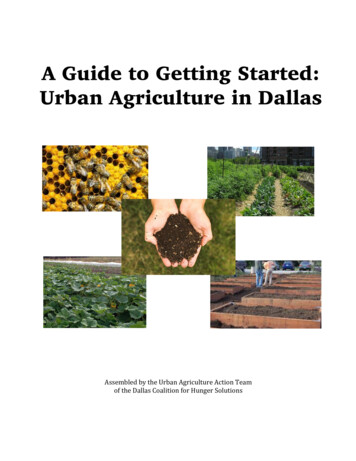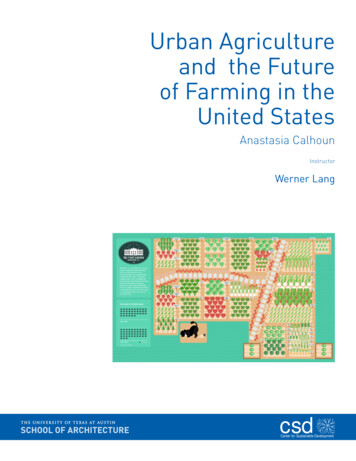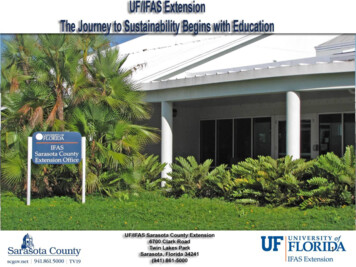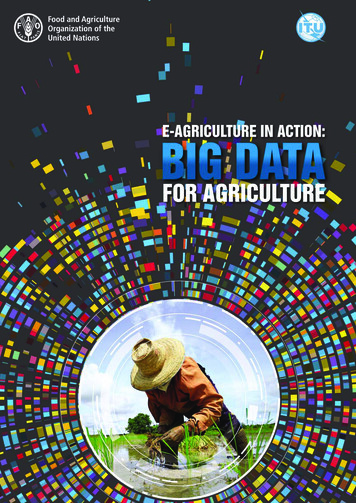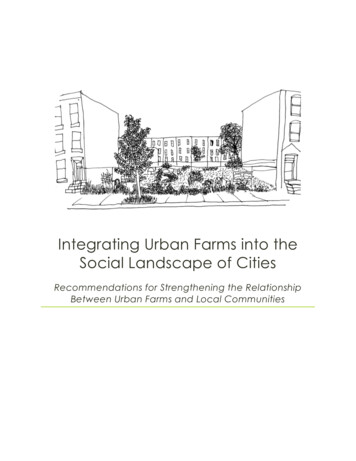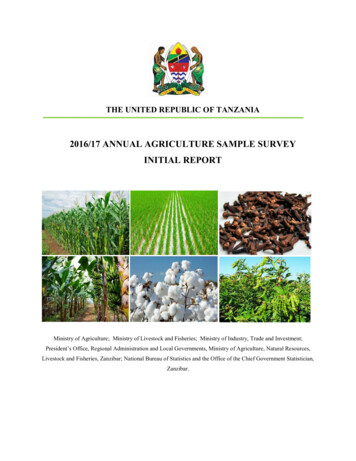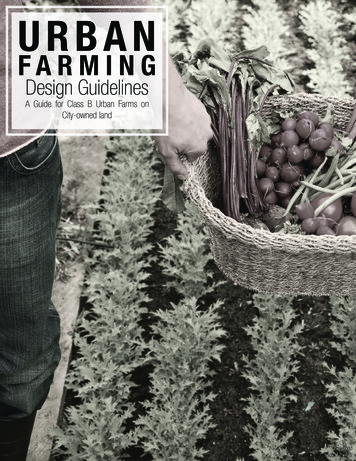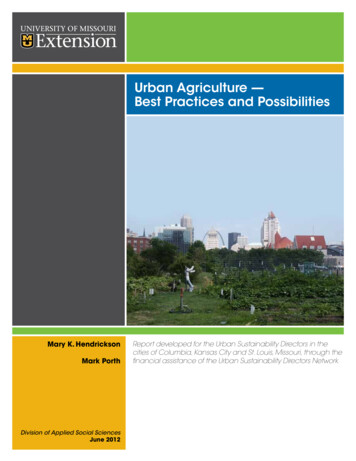
Transcription
Urban Agriculture —Best Practices and PossibilitiesMary K. HendricksonMark PorthDivision of Applied Social SciencesJune 2012Report developed for the Urban Sustainability Directors in thecities of Columbia, Kansas City and St. Louis, Missouri, through thefinancial assistance of the Urban Sustainability Directors Network
contentsAbstract4Introduction5Project methodology5Definitions of urban agriculture and local food systems6Structure of this report8Key questions about urban agriculture and food systems10City ordinances and zoning regulations12Access to water / Access to capital17Brownfields and contaminated soils19Food policy councils21Health food access24Local food system infrastructure27Aggregation and distribution28Processing31Missouri’s urban agriculture33Conclusions37Best practices for encouraging and promoting urban agriculture38How-to approaches rely on communication38Bridging the gaps: What work may need to be done39Appendix413
AbstractThis report provides an overview of urban agriculture and local food system resources andpractices across the United States and parts of Canada, with a primary emphasis on providingresources that can encourage and support urban agriculture in Missouri’s metropolitan areas.We analyzed information from a survey of Urban Sustainability Directors Network memberswho belong to either the national network or the Heartland Sustainability Network. We provideexamples of emerging practices that are working well for cities and collate a number ofresources that exist for cities and their urban agriculture practitioners and advocates. Thisinformation is accessible in this report, but is highlighted in the website created for this projectat iculture.aspx, which includesa public, searchable database that provides documents and websites of zoning ordinances,promotional and educational information, and resources on urban agriculture and food systems.4
IntroductionAt the request of the cities of Kansas City, Columbia and St. Louis, we seek to provideresearch-based guidance that can help these cities to realize the potential of regional foodsystems as an entrepreneurial strategy for urban economic development, paying specialattention to urban agriculture. In particular, these cities were interested in seeing how regionalfood systems can be developed to bring together the interests of municipalities, advocates andpractitioners.Our specific objective was to assess and compile best practices and policies to promote urbanagriculture, working with members of the Urban Sustainability Directors Network (USDN) andurban agriculture advocates and practitioners in the cities of Kansas City, Columbia and St.Louis. This report joins several other major guides and assessments that have been publishedrecently in the constantly changing field of urban agriculture. The results of this project arepresented in several different formats. First, this written report helps to define and describeurban agriculture and local food system efforts within Missouri’s metropolitan areas and othercities across the nation. A report is a static document that is good only at the time of writing.Thus, a second output of this project is a dedicated web page created within University ofMissouri Extension’s website to provide information and resources on urban agriculture aspart of larger food system efforts. The third output, a searchable database housed on thewebsite, contains links to existing resources that cities can use to support and encourage urbanagriculture and local food system strategies. This database also affords access to existingordinances concerning urban agriculture as well as educational and promotional efforts madeby cities to help advocates and practitioners of urban agriculture. This database is meant to bea dynamic tool that can help cities share information and resources with each other and thegeneral public in the rapidly emerging field of urban agriculture.Project methodologyTwo primary methods were used to collect data for both the written report and the webpage. First, we conducted an online survey of USDN members and members of the HeartlandSustainability Network; 29 members responded. This survey included questions about whatkinds of urban agriculture existed in their cities; what challenges urban agriculture facedin their cities; and what kinds of policies, ordinances and practices they used to promoteurban agriculture. The survey included space for respondents to upload any relevant publicdocuments from their cities. Second, we conducted face-to-face interviews with eight advocatesand practitioners of urban agriculture in Kansas City, Columbia and St. Louis. Interviewees wereasked about urban agriculture practices in their cities, challenges faced by urban agriculture inthose cities, and opportunities to work with city government to promote urban agriculture. Alldata gathering was conducted in accordance with the rules of the Internal Review Board of theUniversity of Missouri.While this report draws primarily from the survey and interview responses, it also usesinformation collected and shared through the listserv of the Community Food Security Coalitionon specific urban agriculture practices, ordinances and programs.1 In the course of ourwork, several queries about municipal policies, ordinances, programs and support for urban1The Community Food Security Coalition has existed since 1996. It is one of the most important groups ofpractitioners, advocates and scholars in the United States and Canada connecting nutrition, food security andlocal food systems. Its mission is “to catalyze food systems that are healthy, sustainable, just, and democratic bybuilding community voice and capacity for change.” See http://foodsecurity.org/ for more information. The listservis (COMFOOD-L@elist.tufts.edu).5
agriculture surfaced on this listserv. We used answers to these queries not only to supplementthe scan done through the survey but, more important, to cover a wider range of tools andresources for the web page. Finally, material for this report also came from public testimonyreceived by the State of Missouri’s Joint Committee on Urban Agriculture. Hearings wereconducted in four cities in Missouri from July to October 2011. This testimony was reviewed forrelevant information.Definitions of urban agriculture and local food systemsThe popularity of urban agriculture has increased considerably in the last few years asconcerns about the environment have combined with increased interest in health andcommunity-building issues, giving rise to support for food systems in metro areas as an integralpart of a sustainable development path for cities. More cities, advocates and practitioners aremoving to take advantage of the rise in interest in sustainable local or regional food systems,but they face many challenges, which accounts for the fact that a number of resources providedin this document have appeared only within the last six to twelve months.Many of the respondents to our survey mixed conversations about local food systems withquestions and policies dealing specifically with urban agriculture, which is actually onesubsector of a city’s food system. A food system is all the growing, processing, distributing,retailing, consumption and waste disposal activities associated with food (Figure 1). Definitionsof local food systems often incorporate two other components — the location of these activitiesin a specific geographical area, and specified goals to “enhance the environmental, economic,social and nutritional health of a particular place.”2 However, these definitions vary from placeto place, leading to little consensus on what “local” means. Finding a consensus definitionfrustrated authors of a report on localfood systems prepared by the UnitedStates Department of Agriculture in2010. For their purposes, they defaultedto the Congressional definition in the2008 Farm Bill, which was “locally orregionally produced agricultural foodproduct [that] is less than 400 milesfrom its origin, or within the State inwhich it is produced.”3 Clearly, localfood systems and urban agriculturevary substantially from place to place,making them sensitive to local contextand the specific people involved;thus, cities must define and clarify theirmeanings for urban agriculture and foodFigure 1. A food system and its components.system issues when changing codes orwhen providing education and resources.A city’s food system is fed by local, regional and global systems of production andconsumption. In local food systems, the emphasis is on building community relationships inthe food system that can meet overall goals of enhancing the health, economy, society andenvironment of a particular place. For instance, while a notion of geographical place has beenat the heart of local food system discussions, the USDA report concluded that consumersoften associate other characteristics with local food systems such as marketing arrangements(e.g., direct farmer-to-consumer marketing like farmers’ markets), product characteristics (e.g.,2Garrett, S., and Gail Feenstra. 1999. Growing a Community Food System. Pullman, Wash.: Western RuralDevelopment Center.3Martinez, Steve, et al. Local Food Systems: Concepts, Impacts, and Issues. ERR 97. U.S. Department ofAgriculture, Economic Research Service. May 2010.6
produced with reduced use of synthetic fertilizers or other chemicals,humanely raised), and who produced the food (e.g., ethics of thefarmer, fair labor practices).4Urban agriculture is one component of local food systems. As asubsector of such a complex system, urban agriculture can be definedin many ways and will need to be adapted to the local context. For thepurposes of our project, the definition provided by Bailkey and Nasris used: “The growing, processing, and distribution of food and otherproducts through intensive plant cultivation and animal husbandry in andaround cities.”5 In our face-to-face interviews, respondents generallyfollow the path of Goldstein et al.6 by broadening the definition: urbanagriculture “refer[s] to growing and raising food crops and animalsin an urban setting for the purpose of feeding local populations.Cities choose to narrow and focus this definition in various ways,often categorizing urban agriculture as one or more of the following:community gardens, commercial gardens, community supportedagriculture, farmers’ markets, personal gardens, and urban farms.”One of our interview respondents (M-1) said that “urban agriculture iscommunity-based and community-minded.” We believe it is importantfor cities to understand urban agriculture as a food-producing andcommunity activity, one that is sometimes a for-profit business, especiallyas urban agriculture is incorporated into sustainable development goals.Important Issues for Cities:Policies, education and technicalassistance are going to differ basedon the type and scale of urbanagriculture. Profit-making farms needdifferent support than communitygardens or other more communalor community-based farming. Themajority of urban farms are small,most being less than one acre,which is approximately half a cityblock. However, larger scale urbanfarms – from four acres to 100acres – are possible. With intensivecultivation and good marketingpractices, urban farming businessescan gross more than 50,000 peracre, which may be an importanteconomic development tool.Figure 2 shows that survey respondents generally believe that urban agriculture is usedto supplement household income or to provide food for the household. This may not reflectreality, but as we show in this report, there is little ongoing research to provide answers to thisquestion. Thus, cities may want to separate out forms of urban agriculture that are primarilyprofit-based – essentially farming in the city7 – from those that exist primarily to benefitthe common good (e.g., community gardening) when thinking about policies, education ortechnical assistance that can or should be provided (Figure 3).Cities should also understand matters of scale in urban agriculture. Although many urbanfarmers are small producers who use profits mostly to subsidize household income rather thanmake a living, it is important that cities understand that urban agriculture projects can also belarge-scale. For example, the FarmWorks project in St. Louis envisions redeveloping a four-acresite in the downtown area to provide jobs, fresh foods and processing in one place.8 In KansasCity, Kansas, a two-acre plot of organic land grosses over 100,000 in sales for CultivateKansas City, a nonprofit that uses the land as a farm incubator.9 In Detroit, one private investor,Hantz Farms, and Michigan State University have both announced plans to establish large-4Ibid.5Bailkey, M., and J. Nasr. 2000, From Brownfields to Greenfields: Producing Food in North American Cities,Community Food Security News, Fall 1999/Winter 2000:66Goldstein, M., et al. (2011). Urban agriculture: a sixteen city survey of urban agriculture practices across thecountry. Page 4. Retrieved from ort.pdf.7The U.S. Department of Agriculture defines a farm as “any operation that sells at least one thousand dollarsof agricultural commodities or that would have sold that amount of produce under normal circumstances.” Forinstance, urban farmers can qualify for assistance under USDA farm programs, including those for conservationand income support.8Written testimony provided by Farm Works at the Missouri Joint Committee on Urban Agriculture hearing inMaplewood, Mo., on October 4, 2011.9Testimony from Katherine Kelly provided to the Missouri Joint Committee on Urban Agriculture hearing in KansasCity, Mo., July 11, 2011.7
acreage urban farms of 100 acres or more.10 Thus, it is important for cities to understand urbanagriculture as private enterprise that can exist from a micro to macro scale.Interest in urban agriculture as a viable economic enterprise is reflected in some responsesto our survey of USDN members. For instance, a couple of respondents specifically asked forresources that would help them answer the following questions: How can we address the financial viability of urban or peri-urban farming or incentivizeurban/peri-urban agriculture to increase food security but also consider issues ofaffordability? Can urban agriculture create full-time employment through food production?Other cities responded that they were working on activities to make urban agriculture morefinancially viable, including establishing a centralized incubator farm11 and working with locallenders to help capitalize urban food production efforts.Structure of this reportWe have chosen to focus on a few key areas in this written report, including key questionsthat USDN members and urban agriculture practitioners/advocates have about urbanagriculture; city ordinances and zoning regulations; access to water and capital; brownfieldsand contaminated soil; food policy councils; food access; local food system infrastructure;and Missouri-specific information. These particular discussions follow this introduction. Eachsection presents a discussion of the issues, an analysis of USDN members’ interest in thoseissues, and a highlight of either a best practice or a best resource. In the concluding section,we identify some gaps in the work and discuss overall ways that cities can successfully dealwith local food system and urban agriculture work. As noted above, this written report is onlyone of the outputs of this project.Another key output is the development of a web page at the University of Missouri thatincludes a searchable database of educational resources, reports, best practices and specificordinances that apply to urban agriculture or local food systems. We believe this databasewill be the most significant output of this work for its ability to function as a dynamic tool forUSDN members and the general public. See the screen shot on p.10 of the opening page of thewebsite, which provides access to the searchable database and an online copy of this report.10Gallagher, John. 2012. “Michigan State proposes 100-acre, 100-million urban-farming research center inDetroit.” Detroit Free Press. April 13. Also consulted Hantz Farms website at http://hantzfarmsdetroit.com/.11For good examples of urban farm incubators, see Cultivate Kansas City (http://www.cultivatekc.org/) and GrowingPower in Milwaukee (http://growingpower.org/).8
%NotatallVeryli5leSomewhatToagreatextentFigure 2. How urban agriculture is used in cities.Figure 3. Most common forms of urban agriculture surveyed in cities.9
key questions about urbanagriculture and food systemsSearchabledatabase becomesa dynamic tool forurban agriculturepractitioners, cityofficials and thegeneral public.Written report andanswers to the surveyof USDN members willbe placed here whenfinalized.In general, we have noted these key questions that have been arising about urban agriculturebased on analysis of queries on listservs, interviews and in a limited review of the literature:(note that questions are grouped by level of frequency; bold type representing the most frequentquestions and italic type representing the less frequent.) How can city municipalities and practitioners work together to make urban agriculturefinancially affordable? (e.g., How can practitioners afford the cost of access to water?) How can urban agriculture be better incorporated into city plans? What are the benefits and selling points for urban agriculture? How can we get more people involved in urban agriculture? How have other cities handled liability issues, and what are some of the best managementpractices for urban agriculture? What are other cities/practitioners/advocates doing to promote the growth of urbanagriculture? Is there a way to map our existing resources in each city?10
USDN members are generally struggling with many of the same questions, but USDNmembers are primarily interested in the “how-to” strategies: Political engagement and community organizing (e.g., How can we incentivize thecommunity in urban agriculture projects? What models have other communities used toorganize urban agriculture efforts?) Land use and associated city ordinances (e.g., How has urban agriculture been includedin zoning? How can greenbelts be used for urban agriculture? How can we changecumbersome zoning that thwarts urban agriculture?) This issue has received the mostattention from cities, and there are a number of resources highlighted in this report andloaded in our database that specifically address these issues. Access to capital (e.g., How can one get access to capital for urban farmers?) This isparticularly important as access to capital is seen as a key barrier to expansion of urbanagriculture efforts. Support for local foods (e.g., How can we make institutional purchasing of local foodsfeasible for both the city and local growers? How can we cultivate food hubs?) Liability (e.g., How have cities handled the “liability issue,” particularly regardingcommunity gardens and edible landscaping on public lands?)Urban agriculture practitioners and advocates in St. Louis, Columbia and Kansas City,Missouri, are also interested in “how-to” issues: Land use and city ordinances that could support urban agriculture, including a desire forresources from other cities. Best practices for food production and food safety in urban agriculture.But they are also concerned with finding information that could help them position urbanagriculture for the future: Research and evaluation of urban agriculture’s economic, social and other benefits. Future trends in urban agriculture, including larger questions of overall developmentstrategies for cities.We have identified a gap in the academic literature where there is little data on the longterm benefits that urban agriculture can provide. Many of the benefits are assumed, asinterest in urban agriculture generally increases during times of economic uncertainty andthen decreases when stability is restored,12 leading to a dearth of research on the long-termimpacts. However, simply collecting data at the city or metropolitan level could help citiesmake good decisions about the best ways to incorporate urban agriculture into overall plans.12Mukherji, N., and A. Morales. 2010. Practice urban agriculture. Chicago: American Planning Association. Page 2.11
city ordinancesand zoning regulationsUrban agriculture can offer health, environmental and economic advantages that make it anappealing movement. For example, farming in cities can provide increased access to healthy,cheap produce for urban residents, while lowering pollution impacts from transportation andwaste products.13 Urban agriculture also has the potential to help in the economic revitalizationof cities through the use of vacant land and the potential to use urban agriculture for smallbusiness opportunities. However, there are typical concerns associated with urban farming,including aesthetics, worries over property value, and concerns about nuisances. Zoningregulations are well suited to balance these concerns and benefits because they are designedto regulate competing land uses and thus should be a starting point for any municipalityinterested in promoting urban agriculture. In fact, 13 of our respondent cities indicated theywere reviewing city ordinances, and another eight indicated they were reviewing policies suchas food codes. (See Table A2 in Appendix for more information.)While municipal efforts to accommodate urban gardening have been useful, many areineffective amendments that fail to take a broader view in addressing urban agriculture.14Unfortunately, a piecemeal approach can serve to discourage urban farmers because it addscomplexity and increases costs, thus deterring would-be farmers and entrepreneurs. To makefull use of urban agriculture as a tool for promoting revitalization of a town or city, officialsshould consider a more comprehensive approach for incorporating urban agriculture into theirzoning regulations.15 Such an approach would involve steps that clarify the city’s support forurban farming, standardize the urban farming activities that are permitted, and facilitate thesale of goods produced from those permitted activities.16 Because a city’s comprehensiveplan is where a municipality identifies the goals and priorities it seeks to implement throughits zoning code, such a plan is an important starting point for a community committed toencouraging urban farming through land use controls.17USDN member cities are making critical strides in this direction. Because urban agricultureis being practiced in so many of USDN members’ cities, the majority of survey respondents (21of 29) said that urban agriculture was addressed in their city plan. This corresponds to findingsfrom 16 case studies on urban agriculture conducted for Georgia Organics by the Emory LawSchool in 2011 where most cities had some provision for urban agriculture in their zoningordinances.18 However, as we see throughout the report, clarity on goals for urban agriculture isimportant.When asked to “List the goals related to urban agriculture that your city’s comprehensive planaddresses or will address,” respondents gave a wide variety of answers, but the mode (7) was“create sustainable food systems” (see Table 1). At least three respondents directly mentionedhealth, primarily access to healthy foods, and another four specified a focus on communitygardening in some form. However, there were also goals associated with community economicdevelopment (2), local foods (3), and zoning. Most cities were trying to address overall goals13Mukherji, N., and A. Morales. 2010. Practice urban agriculture. Chicago: American Planning Association.14Pothukuchi, K. J. K. (January 01, 2000). The food system: A stranger to the planning field. Journal of PlanningLiterature, 15, 1.)15Mougeot, L. J. A., and International Development Research Centre (Canada). 2006. Growing better cities: Urbanagriculture for sustainable development. Ottawa: International Development Research Centre.16See Mukherji and Morales 2009.17National Policy and Legal Analysis Network to Prevent Childhood Obesity. 2009. Public Health Law and Policy,Establishing Land Use Protections for Community Gardens 2, 4.18Goldstein et al. 2011.12
of sustainability by including urban agriculture in their comprehensive plans as evidenced bythe inclusion of goals related to developing local food systems, or overall community economicdevelopment. Table A2 in the Appendix shows the approaches used in various cities to includeurban agriculture and food systems in their comprehensive plans.Table 1. Goals in comprehensive planCitiesCreate sustainable food systems7Address or support community gardening4Use urban agriculture for community economic development2Support access to healthy foods to address health issues3Support local foods3Create open space1In our survey, the city ordinances and zoning were key challenges to urban agriculture(see Table 2), where 83% of respondents reported city ordinances were sometimes, often oralways a problem; zoning was reported by 76% of respondents as sometimes, often or alwaysa problem. Health codes, homeowner association restrictions and contamination/brownfieldswere less problematic, but all were considered barriers at least some of the time. Over 40% ofrespondents said that health codes and homeowner association restrictions were rarely or neverproblematic.Table 2.To what degree has each barrier prevented residents from developing urban agriculture projects in your city? (N 29)NeverRarely SometimesOftenAlwaysNoresponseModeMeanHealth times3.17City ordinances0514820Sometimes3.24Access to water0412931Sometimes3.28Access to capital0161570Often3.97Homeowners tion/ brownfieldredevelopment3713410Sometimes2.75Most cities were trying to address the barriers identified above in some way either bychanging ordinances or by reviewing policies that act as barriers to urban agriculture (18 of 29cities).By amending its model ordinances to include support for urban agriculture, a municipalitycan establish urban agriculture as a priority in its communities and set the stage for therevision of its zoning regulations. When incorporating urban agriculture into its plan, a cityshould include its goals and objectives for urban agriculture, and the policies and actions itwill use to implement those goals and objectives. To do this, the municipality should identifythe benefits it is hoping to gain from promoting urban agriculture. These benefits can includehealth, environmental, or economic benefits; for example, access to fresh, local produce,“additional open areas, nutrition or job training for their children, community gathering spaces,13
increase economic opportunities,” or promoting “community gardening opportunities, nonprofitprograms or small businesses.”19Traditional planning policies can be critically important for urban agriculture. While urbanagriculture and local food systems have largely emerged as a grassroots movement in the last15 years, the movement has developed to the point that cities need to plan for it to the sameextent as they do for streets, buildings or other infrastructure. In 2011, the American PlanningAssociation20 provided recommendations for cities in addressing ordinances, zoning regulationsand city plans, calling for: Use of non-zoning regulations that affect private land(e.g., animal control and residential composting ordinances) Land use policies that promote public land to be used for gardens or farms(e.g., Hartford, Conn., keeps track of all of its vacant public lands to match gardeners tothose lots) Land disposition policies that permit surplus properties to be acquired for urbanagriculture Policies and regulations that strengthen infrastructure for widespread urban agriculture(e.g., abandoned property management programs, brownfield cleanup programs, localprocurement policies)As summarized in the Missouri-specific section below, tenure and security of land is akey issue for urban agriculture practitioners. Without security on the land, urban farmersare unlikely to make investments in soil or infrastructure that could lead to more productivefarms and greater availability of locally produced food products in cities. For instance,soil remediation and improvement is a long-term strategy thaturban farmers will be working on for the life of their enterprise.Infrastructure investments such as water lines or hoop houses21In June 2010, the city council ofrequire multiple years to show a return on investment. Both urbanKansas City, Mo., reviewed andfarmers and community gardeners need security on the land, so citiesupdated codes affecting urbanshould work with urban agriculture advocates and practitioners to findagriculture activities. The new codethe best practices for transference of vacant lots and use of publicsecures the right of homeownersland for food production.to grow produce in their front yardInformation about zoning practices identified during our studyfor consumption or off-site sales;isavailable through a searchable database at http://extension.allows for on-site sales from gure 4 is afarms; enables local growers toscreen shot of how the database works as a search engine. To date,have apprentices and interns; andwe have entered over 100 articles and resources into this database.allows gardening as a principal orHowever, it will remain a dynamic tool that can be updated for a longaccessory use of a pr
on the type and scale of urban agriculture. Profit-making farms need different support than community gardens or other more communal or community-based farming. The majority of urban farms are small, most being less than one acre, which is approximately half a city block. However, larger scale urban farms – from four acres to 100
